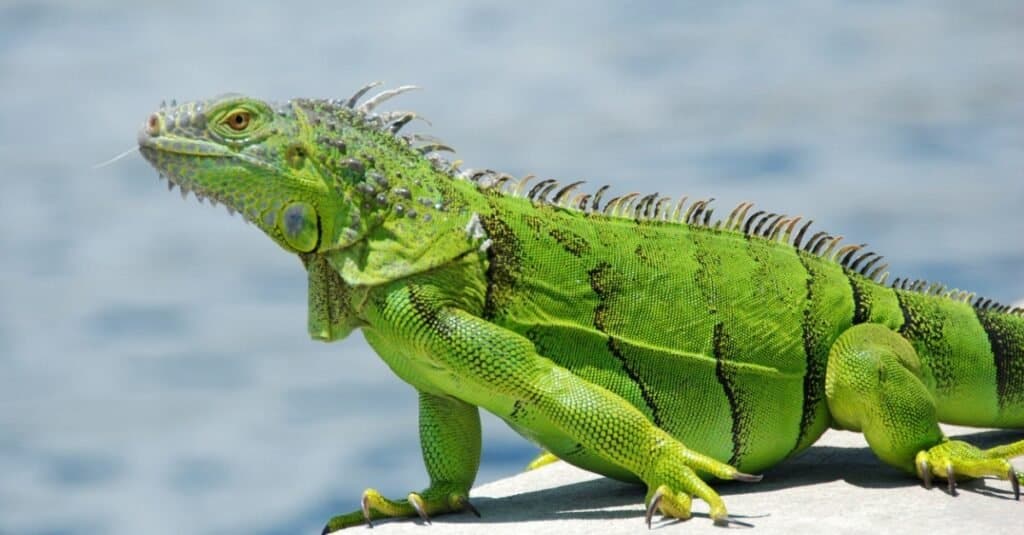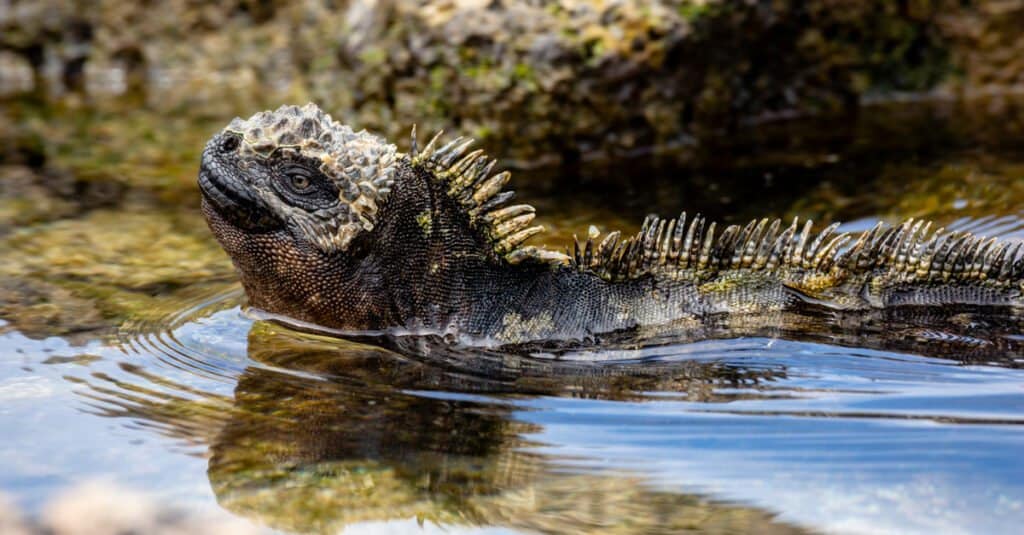Although many lizards are technically capable of swimming, most of them aren’t particularly strong swimmers. However, plenty of larger species that live in hot, humid environments, such as monitor lizards and iguanas, are much better adapted to water. But can iguanas actually swim, and do any of them truly like water?
Let’s explore various types of iguanas’ swimming abilities, why certain species are stronger swimmers than others, how fast they can swim, and if any are truly aquatic. You’ll likely be surprised at just how well these massive reptiles have evolved to expertly traverse bodies of water!
Can Iguanas Swim?

Marine iguanas
are by far the strongest swimmers within the Iguanidae family.
©Danita Delimont/Shutterstock.com
Of the 40 or so species within the Iguanidae family, most of them are at least capable of swimming short distances when they need to. Even though they’re usually arboreal, iguanas still come down from trees often to eat, drink, sun themselves, and mate.
After all, iguanas generally thrive in hot, humid environments with large bodies of water. These areas include rainforests throughout Central and South America as well as various islands in the Caribbean. This means they need to be ready to traverse rivers and lakes often, so they’ve evolved to swim quite well. These areas are also prone to floods and hurricanes, so even species that don’t swim much normally, such as rock iguanas, can do so in a pinch to get to safety.
In addition, iguanas are longer and more muscular than smaller lizards, which makes them better suited to swimming. Rather than using their legs to propel themselves through the water, though, they prefer to primarily use their long, strong tails!
Many species, like the green iguana, simply pull their legs close to their bodies and wiggle their tails back and forth to propel themselves through the water in a torpedo-like fashion. However, they’ll also use their semi-webbed feet to take over from time to time.
A few types of iguanas living in the Caribbean spend most of their time surrounded by water and regularly go for swims for exercise and in search of food. These species tend to be stronger, faster swimmers than those living in more land-locked regions. Water-loving marine iguanas, for example, regularly take to the ocean to find food like algae and seaweed to munch on.
In short, virtually all iguanas can swim, even the ones you wouldn’t expect!
How Fast Can Iguanas Swim?

Even though green iguanas are fast runners, they swim at much slower speeds.
©iStock.com/Travel_Bug
Even though iguanas can swim and are strong swimmers, most species aren’t especially fast. While they are very speedy on land, iguanas typically only swim at speeds of around 1.5 feet per second. This is roughly on par with a human’s average swimming speed.
Some, however, are slightly faster than this average, like the aforementioned marine iguana. Since these iguanas spend most of their time in the Galapagos surrounded by the ocean, they’ve adapted well to swimming and even diving. Others, like the Fiji banded iguana, are also quite adept at swimming for similar reasons.
Island-dwelling iguanas tend to have longer, stronger tails that can propel them more quickly through the water compared to their counterparts living in Central and South America, for example. However, even the few species that live in drier areas, like the desert iguana, can swim surprisingly quickly, as they mostly reside near Mexico’s coasts.
Do Iguanas Like Water?

Even captive iguanas greatly enjoy having water containers to soak in to assist with shedding
©Cocos.Bounty/Shutterstock.com
Because their bodies are so well-equipped for swimming, iguanas tend to enjoy being in water, at least for short periods of time. They often will hop in nearby lakes and rivers to regulate their body temperature on very hot days. Others will traverse bodies of water as quick shortcuts to evade predators, find food, or simply to get from place to place a bit more quickly.
Additionally, since they’re cold-blooded, or ectothermic, iguanas need to be clever when it comes to cooling off or staying warm. Large bodies of water also provide a fast, easy method of hydration when other smaller water sources are scarce.
Most iguanas that live on islands in the Caribbean or elsewhere especially enjoy water. Because they’re surrounded by it constantly, these species have evolved to thrive in water with numerous adaptations. Marine iguanas in particular have strong, wide, paddle-like tails, and webbed feet. What’s more, they can hold their breath for as long as 30 minutes without having to come to the surface for air!
Even in captivity, virtually all species of pet iguanas need a large enough container of water to soak their entire bodies in. Regardless of their species, all iguanas need water to soak in to assist with shedding their skin. Many reptile owners even put their iguanas on harnesses and take them for a swim at local pools, lakes, and rivers! Just keep them away from chlorinated pools, as these chemicals are very harsh on their skin.
Do Any Iguanas Live Underwater?

Even though they’re surrounded by water, marine iguanas aren’t fully aquatic.
©buteo/Shutterstock.com
Although plenty of iguanas love water, there are no fully aquatic iguana species. Iguanas are reptiles, not amphibians or fish, so they lack gills to allow them to breathe underwater. Most iguana species, however, can hold their breath for anywhere from 10 minutes to up to an hour if they need to, for example, survive a sudden flood or hurricane or dive for food.
Once again, we come back to the marine iguana, perhaps the most water-loving species of all. This particular iguana is not only a strong swimmer but an exceptional diver! They commonly dive to depths of 10 to 20 feet in search of algae and seaweed to feed on. They can technically dive as deep as 100 feet, but this is rare.
Overall, though, very few iguanas are capable of diving very far underwater. Aside from the marine iguana, most species rarely dive below 10 feet at a time. They tend to stick to the surface when they go for a swim.
The photo featured at the top of this post is © Danita Delimont/Shutterstock.com
Thank you for reading! Have some feedback for us? Contact the AZ Animals editorial team.






